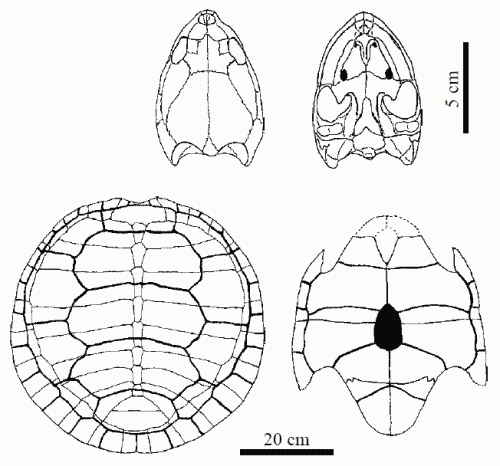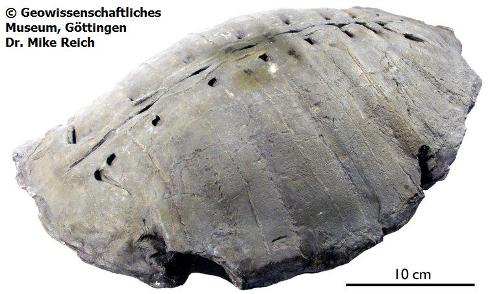Chelonii: Eucryptodira
Taxa on This Page
- Angolachelonia X
- Angolachelys X
- Centrocryptodira
- Eucryptodira
- Plesiochelyidae X
- Sandownia X
- Solnhofia X
- Thalassemyidae X
Beginning in the later Middle Jurassic, the testudines underwent an evolutionary radiation and became a very successful lineage. The basal Paracryptodires were supplemented by a variety of Eucryptodires, including a number of early marine types that were quite unrelated to the Chelonoidian marine turtles of the Cretaceous to Recent. More advanced were the Sinemydidae seem to be ancestral to extant hard-shelled turtles, although they are so far known only from theCretaceous and early Cenozoic. Two groups with ambiguous positions on the Chelonian tree, the Pleurodires (side-necked turtles) and the Meiolaniids (horned tortoises) developed probably as offshoots from the early cryptodire or proto-cryptodire stem. MAK130112
Descriptions
Eucryptodira Gaffney, 1975
Range: Late Jurassic to Recent, Cosmopolitan
Characters: Mesoplastra absent, Canalis caroticus is formed by the pterygoid.
Comments: Eucryptodira was coined by Gaffney, 1975 for all crown-group cryptodires together with a number of basal fossil forms, although its status is ambiguous. The absence of mesoplastra is also a characteristic of Chelidae. Mesoplastra a primitive condition present in Proganochelys and most Pleurodires. Basal forms are characterised by amphicoelous cervical (neck) vertebrae with poorly developed articulation, whereas the more specialised Centrocryptodira (and also the Pleurodires) have more efficient articulation (Meylan 2001). Joyce (2007) and Anquetin (2009) recovered this clade using a different metholodology and matrix to Gaffney, but Sterli 2008 and 2010 and Pérez-García & Murelaga (2012) did not. The taxon is best defined as an assemblage of early cryptodire-like forms combining characteristics or paracryptrodires, pleurodires, and crown cryptodires, but more primitive than the latter two groups. MAK121126 130117
Thalassemyidae
Range: Late Jurassic (Late Kimmeridgian to Early Tithonian) of Bavaria and Switzerland
Comments: Thalassemys and the contemporary Eurysternum are similar and may or may not be closely related. About half a dozen species are known from the late Jurassic of Switzerland and Germany, the largest, T. hugii, has a shell 1.2 meters long, although others are much smaller (E. wagleri being only 18 cm). According to both Anquetin (2009) and Mateus et al (2009), Thalassemys moseri is the sister taxon of the basal protostegid Santanachelys gaffneyi (Anquetin, following Joyce (2007), places "Thalassemys moseri" in inverted commas implying this species probably belongs in a separate genus); Mateus et al (2009) to the medium-sized (shell 40 cm long) Thalassemys marina of Wurttemberg). This is not to deny the possibility of convergence; indeed we can expect a lot of parallelism among seperate and unrelated lineages of marine cryptodires. Hence protostegids are traditionally placed as the sister group of Dermochelyidae, although recent cladistic analyses, beginning with Joyce (2007) show that the protostegids are actually a much more primitive group. Clearly the late Jurassic and Early Cretaceous saw a number of distinct but parallel explorations in aquatic and marine lifestyle among chelonians. It can be assumed that forms like Thalassemys, Eurysternum, Plesiochelys and Portlandemys they belong to a general grouping of European (central Laurasian) marginal marine (and semiaquatic) primitive Eucryptodires, but the precise relationship of these early marine turtles will probably always remain rather ambiguous. MAK130112
Portlandemys
Range: Latest Jurassic (Late Tithonian) to England
Comments: This phylogenetic placement follows Mateus et al (2009). MAK130111

Skull and shell of Hylaeochelys belli (Mantell, 1844). Purbeck Limestone Formation, Early Cretaceous (Berriasian), Durlstone Bay near Swanage, Dorset County, UK. Skull based on holotype of Dorsetochelys delairi Evans and Kemp. Carapace largely based on holotype of "Pleurosternum latiscutatum" Owen, 1853 with additions from holotype of "Pleurosternum emarginatum" Owen, 1853 [Hirayama et al, 2000, p.186] |

Hylaeochelys menkei, Early Cretaceous: Berriasian, Bückeburg, Lower Saxony, Germany. Photo from Fossil turtles |
Range: Late Jurassic (Kimmeridgian) to Early Cretaceous, Europe and Asia
Phylogeny: Eucryptodira : ("Thalassemyidae + Protostegidae) + (Portlandemys + ((Angolachelonia + Xinjiangchelyid - Crown Cryptodire clade) + *))
Characters: shell thick, mesoplastra absent (Zittel 1932 p.307), broad vertebral scutes and strong plastral buttresses reaching costals (Hirayama et al, 2000 p.185), amphicoelus articulations between succeeding cervical vertebrae, which is a more primitive condition of the cervical vertebrae (also found in Pleurodira and Baenidae). Thin floor where pterygoid forms the canalis caroticus internus, which seems to be a primitive condition. In some specimens of Plesiochelys the seam or suture closing the canalis is still present. The thick, seamless condition is seen in all other eucryptodires, and is considered more advanced because during development the canalis floor is thin at first and shows the enclosing of the carotid. (Meylan 2001.)
Comments: medium-sized marine turtles. Once considered ancestral chelonioids, they are now interpreted as basal Cryptodires. Plesiochelys has a shell upto 50cm long, considerably vaulted in the adult (Zittel 1932 p.307). Pending phylogenetic analyses of Plesiochelys and Hylaeochelys in relation to other taxa or even each other, these are both incxluded under the family Plesiochelyidae. Eurysternidae and Thalassemyidae include similar, poorly known contemporary aquatic forms. MAK130112
References: Hirayama et al, 2000 p.185, Meylan 2001, Zittel 1932.
Range: Late Jurassic (Kimmeridgian) to Early Late Cretaceous (Turonian) of Europe, Africa, and North America
Characters: mandibular articulation of quadrate aligned with or posterior to the occiput, and basisphenoid not visible or visibility greatly reduced in ventral view. (Mateus et al 2009).
Comments: New clade of Mesozoic turtles recovered by Mateus et al (2009), based on the newly discovered eucryptodire Angolachelys mbaxi using the data set of Joyce (2007). As can be seen from the adjacent map (right), these animals were part of the evoplutionary and ecological radiation that resulted from the opening of the South Atlantic ocean (although at this time it was still a narrow sea). The protostegids, beginning with Santanachelys, represent a distinct, and ultimately more succesful, evolutionary lineage. Unlike the angolachelonians, the protostegids did not represent the first taxon to pass through the Atlantic gateway , because early Cretaceous forms from Australia (Kear 2003) pre-date the opening of the Atlantic Ocean (Mateus et al (2009) p.588). MAK130112
Chronopaleogeography of basal eucryptodires. The paleogeographic maps are from www.odsn.de and Hay et al. (1999). The grey bar represents the time for the opening of South Atlantic. Diagram and caption by Mateus et al (2009) p.587, fig.5
Solnhofia parsonsi
Range: Late Kimmeridgian - Early Tithonian of Bavaria
Sandownia harrisi
Range: Aptian of the Isle of Wight
Comments: The skull of Sandownia harrisi has one of the most extensive secondary palates among turtles, perhaps associated with the development of a broad crushing surface (Meylan et al., 2000, cited in Pérez-García & Murelaga (2012)). Variously considered an ancestral trionychoidan (Meylan et al., 2000) or an abarrent early eucryptodire (Joyce (2007), Anquetin (2009)). We have used the phylogenetic placement of Mateus et al (2009), who note that the apparent lack an epipterygoid makes Sandownia even more derived than Angolachelys (ibid, p.587). MAK130112
Angolachelys mbaxi Mateus et al 2009
Range: Tadi Beds, Itombe Formation, of Angola, Late Turonian, Late Cretaceous
Characters: "divided external nares separated by an internarial process of the premaxilla; sub-circular rugosity on the dorsal surface of the squamosal; squamosal wings projected posteriorly, representing about 1/4 of the total length of the skull posterior to the quadrate, and frames the temporal fenestra both dorsally and laterally."
Comments: The oldest known African Eucryptodire, and represents the first marine turtle lineage to cross from the North to South Atlantic during the Mid Cretaceous opening of the South Atlantic seaway (Mateus et al (2009) p.588). Shares a number of characteristics with Sandownia (the expansion of the jugal onto the secondary palate, trilobate outline and pre-maxillary prominence of the rostrum) which seem to be unique features among turtles (Mateus et al (2009) p.587). This supports the status of Sandownia as a stem eucryptodire rather than a basal trionychoidan, An unnamed taxon from the Albian of Glen Rose, Texas would seem to be slightly moree distrantly related to both. Mateus et al (2009) MAK130112
checked ATW030512, ATW030416. Page last modified MAK121126. All material by ATW is public domain and may be freely used in any way (also any material jointly written by ATW and MAK). All material by MAK is licensed Creative Commons Attribution License Version 3.0, and may be freely used provided acknowedgement is given. All Wikipedia material is either Gnu Open Source or Creative Commons (see original Wikipedia page for details). Other graphics are copyright their respective owners

